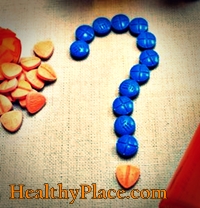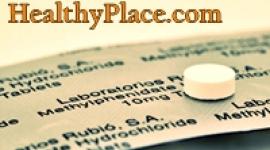ADHD Treatment Overview: Non-Stimulant Medications (Strattera) and Other ADHD Drugs
Stimulant medication isn't the only medical treatment for ADHD. There's non-stimulant medication, Strattera, for ADHD, as well as antidepressants and some blood pressure drugs.
There are many drugs other than psychostimulants that can be used to treat ADHD.
Nonstimulant Therapy for ADHD
Strattera is the first nonstimulant approved for treatment of ADHD. It is also the only drug approved to treat adult ADHD.
 Strattera works on the neurotransmitter (chemical in the brain that transmits nerve impulses) called norepinephrine. Like the stimulant drugs, Strattera is effective in treating and controlling ADHD symptoms, but it is not a controlled substance and people are less likely to abuse the drug or become dependant on it.
Strattera works on the neurotransmitter (chemical in the brain that transmits nerve impulses) called norepinephrine. Like the stimulant drugs, Strattera is effective in treating and controlling ADHD symptoms, but it is not a controlled substance and people are less likely to abuse the drug or become dependant on it.
In addition, Strattera doesn't cause many of the potential side effects linked to psychostimulants, such as sleeplessness. Overall, the drug is well tolerated with minimal side effects.
How Does Strattera Work?
This medication works by increasing the amount of norepinephrine, an important brain chemical, in the brain. Doing this appears to help ADHD by increasing attention span and reducing impulsive behavior and hyperactivity.
What Are the Side Effects of Strattera?
The most common side effects seen with Strattera are:
- Upset stomach
- Decreased appetite, which may cause weight loss
- Nausea
- Dizziness
- Fatigue
- Mood swings
Generally, these side effects are not severe, and only a very small percentage of clinical trial participants stopped Strattera due to side effects.
There have been reports of slightly decreased growth in children and teens. It is recommended that children and adolescents be observed, measured and weighed periodically while on Strattera.
Allergic reactions to Strattera are rare but do occur, usually as swelling or hives. The prescribing doctor or other health care professional should be advised immediately if anyone taking Strattera develops a skin rash, swelling, hives or other allergic symptoms.
On Dec. 17, 2004, Eli Lilly, the makers of Strattera, added a warning to the drug noting Strattera should be stopped in patients with signs of jaundice -- yellowing of the skin or whites of the eyes. Jaundice is a sign of liver damage. If blood tests show evidence of liver damage, the drug should also be stopped.
Who Shouldn't Take Straterra?
There are certain situations in which a person should not take Strattera. If you or your child has any of the following conditions, you should discuss them with your health care provider before taking Strattera:
- Narrow angle glaucoma (a condition causing increased pressure in the eyes and can lead to blindness).
- Treatment with a type of antidepressant called monoamine oxidase inhibitors, such as Nardil or Parnate, within 14 days of starting Strattera.
Straterra: Tips and Precautions
Be sure to tell your doctor:
- If you are nursing, pregnant, or plan to become pregnant
- If you are taking or plan to take any dietary supplements, herbal medicines or nonprescription medications
- If you have any past or present medical problems, including high blood pressure, seizures, heart disease, glaucoma or liver or kidney disease
- If you have a history of drug or alcohol abuse or dependency or if you have had mental health problems, including depression, manic depression, or psychosis.
Strattera should always be taken exactly as prescribed. It is usually taken once or twice a day and may be taken with or without food. No specific laboratory testing is required while taking Strattera and it may be used for extended, or long-term, treatment as long as there are periodic evaluations with your health care provider.
Antidepressant Therapy for ADHD
Several types of antidepressant drugs can be used to treat ADHD. Antidepressant therapy for ADHD is sometimes used as the treatment of choice for children or adults who have ADHD and depression.
Antidepressants, however, are generally not as effective as stimulants or Straterra at improving attention span and concentration.
Antidepressants used for treating ADHD include:
- Tricyclic antidepressants, such as Pamelor, Aventyl, Tofranil, Norpramin, and Pertofrane, have been shown to be helpful in children and adults with ADHD, but they can cause some unpleasant side effects, such as dry mouth, constipation or urinary problems. They are also relatively inexpensive.
- Wellbutrin
- is a different type of antidepressant that is very effective in treating ADHD in adults and children. It is generally well-tolerated but it also has some side effects that may be a problem with some people who have anxiety, headaches or seizures.
- Effexor and Effexor XR are antidepressants that increase the levels of norepinephrine and serotonin in the brain. The drugs are effective at improving mood and concentration in adults as well as children and teens.
- MAO inhibitors are a group of antidepressants that can treat ADHD with some benefit but are rarely used because they have significant and sometimes dangerous side effects and can dangerously interact with foods and other medications. They may be of benefit in people where other medications have failed. Examples include Nardil or Parnate.
Note: In October 2004, The FDA has determined that antidepressant medications increase the risk of suicidal thinking and behavior in children and adolescents with depression and other psychiatric disorders. If you have questions or concerns, discuss them with your health care provider. Learn more
How Do Antidepressants Work to Treat ADHD?
Since most antidepressants work by increasing the levels of brain messenger chemicals (neurotransmitters), such as norepinephrine, serotonin and dopamine, it makes sense that they might have similar effects to other ADHD stimulant and nonstimulant treatments that appear to work by similar mechanisms.
Antidepressant treatment seems to improve attention span as well as impulse control, hyperactivity and aggressiveness. Children and adolescents treated with antidepressants are often more willing to take direction and are less disruptive.
Antidepressants have the advantage of having a low potential for abuse and there is no evidence that they suppress growth or contribute to significant weight loss.
Who Should Not Take Antidepressants?
Antidepressants should not be used
- If you have a history or tendency toward manic behavior or manic depression (bipolar disorder)
- Wellbutrin can't be taken if you have any history of seizures or epilepsy.
- Treatment with antidepressants should not be initiated if you have taken a monoamine oxidase inhibitor antidepressant, such as Nardil or Parnate, within the last 14 days.
- Each type of antidepressant has its own contraindications and usage warnings, and you should discuss these with your doctor.
Side Effects of Antidepressants
The most common side effects experienced with tricyclic antidepressants include:
- Stomach upset
- Constipation
- Dry mouth
- Blurred vision
- Drowsiness
- Low blood pressure
- Weight gain
- Tremor
- Sweating
- Difficulty urinating
Wellbutrin sometimes causes stomach upset, anxiety, headaches and rashes.
Effexor can cause nausea, anxiety, sleep problems, tremor, dry mouth and sexual problems in adults.
MAO inhibitors can cause a wide variety of side effects, including dangerously increased blood pressure when combined with certain foods or medications.
Antidepressants Therapy for ADHD: Tips and Precautions
When taking antidepressants for ADHD, be sure to tell your health care provider:
- If you are nursing, pregnant, or plan to become pregnant
- If you are taking or plan to take any dietary supplements, herbal medicines or nonprescription medications
- If you have any past or present medical problems, including high blood pressure, seizures, heart disease and urinary problems
- If you have a history of drug or alcohol abuse or dependency or if you have had mental health problems, including depression, manic depression or psychosis.
The following are useful guidelines to keep in mind when taking antidepressants or giving them to your child for ADHD:
- Always give the medication exactly as prescribed. If there are any problems or questions, call your doctor.
- Antidepressants usually take 2-4 weeks before the full effects are apparent. Be patient and dont give up before giving them a chance to work!
- Your doctor will probably want to start out at a low dose and increase gradually until symptoms are controlled.
- It is better not to miss doses of antidepressants. Most are given once or twice a day. If you miss a day or two of Effexor, it can cause an unpleasant withdrawal syndrome.
- Tell your doctor if you notice any new or unusual side effects. Taking bulk laxatives (fiber) and drinking lots of water is a good idea with tricyclic antidepressants as they tend to cause constipation and hard stools.
- If you become constipated as a result of taking tricyclic antidepressants, take a bulk laxative (fiber) and drink lots of water.
- Monitor your child, especially when starting antidepressant therapy, for potential suicidal thoughts and behaviors.
Blood Pressure Drugs Used to Treat ADHD
Two drugs, Catapres and guanfacine, normally taken to treat high blood pressure, have been shown to be of some benefit for ADHD when used alone or in combination with stimulant drugs. The drugs can improve mental functioning as well as behavior in ADHD.
How Do Blood Pressure Drugs Treat ADHD?
How these drugs work in treating ADHD is not yet known, but it is clear that they have a calming effect on certain areas of the brain.
Catapres can be applied in a weekly patch form for gradual medication release. This delivery method helps decrease some side effects, such a dry mouth and fatigue. After a few weeks, side effects usually diminish considerably.
Catapres and guanfacine can help reduce some of the side effects of stimulant therapy, especially the sleeplessness and aggressive behavior. However, combining stimulants with one of these drugs is controversial, because there have been some deaths in children taking both stimulants and Catapres.
It is not known whether these deaths were due to the combination of drugs, but caution should be exercised whenever such combinations are used. Careful screening for heart rhythm irregularities and regular monitoring of blood pressure and electrocardiograms help reduce these risks. If your doctor thinks that combining these two treatments offers more benefits than risks, it may be a good option.
Who Should Not Take Blood Pressure Drugs?
Catapres and guanfacine may be contraindicated if there is a history of low blood pressure or other personal or family history of a significant heart problem.
What Are the Side Effects of Blood Pressure Medications?
The most common side effects seen with these drugs include:
- Drowsiness
- Lowered blood pressure
- Headache
- Sinus congestion
- Dizziness
- Stomach upset
These drugs can rarely cause irregular heartbeats.
Blood Pressure Medication for ADHD: Tips and Precautions
When taking one of these drugs for ADHD, be sure to tell your doctor:
- If you are nursing, pregnant, or plan to become pregnant
- If you are taking or plan to take any dietary supplements, herbal medicines or nonprescription medications
- If you have any past or present medical problems, including low blood pressure, seizures, heart rhythm disturbances and urinary problems
The following are useful guidelines to keep in mind when taking Catapres or guanfacine or giving them to your child for ADHD:
- Always take or give the medication exactly as prescribed. If there are any problems or questions, call your doctor. It is best not to miss doses or patches as this may cause the blood pressure to rise quickly, which may cause headaches and other symptoms.
- Your health care provider will probably want to start out at a low dose and increase gradually until symptoms are controlled.
- Catapres patches come in various sizes. Rotate the placement of the patch to avoid skin irritation.
- For very young children, Catapres tablets can be formulated into a liquid by your pharmacist to make giving the medication easier.
next: ADHD Treatment Overview: Psychotherapy
~ adhd library articles
~ all add/adhd articles
APA Reference
Tracy, N.
(2008, December 2). ADHD Treatment Overview: Non-Stimulant Medications (Strattera) and Other ADHD Drugs, HealthyPlace. Retrieved
on 2025, December 13 from https://www.healthyplace.com/adhd/articles/non-stimulant-drugs-for-adhd-treatment

